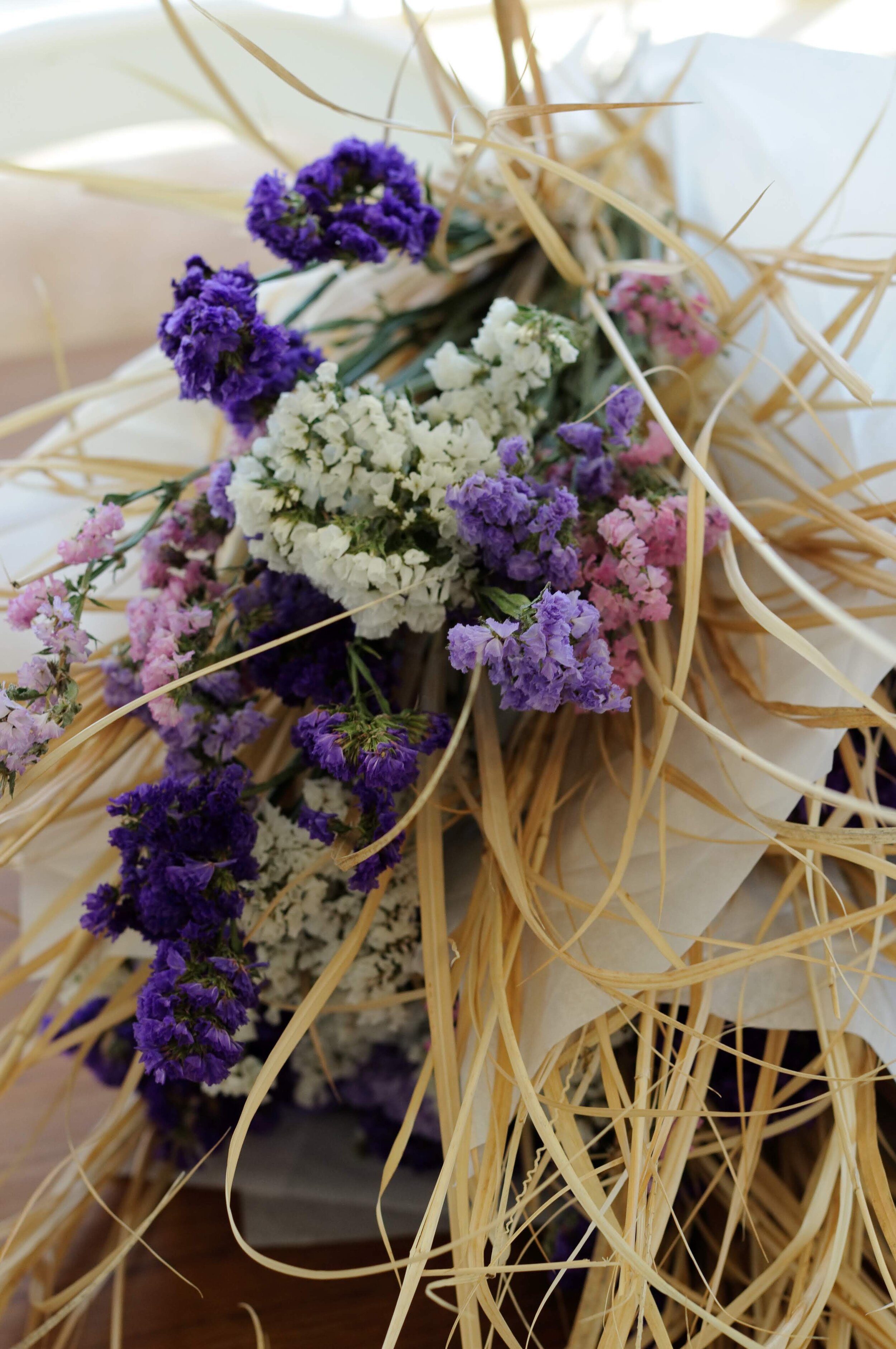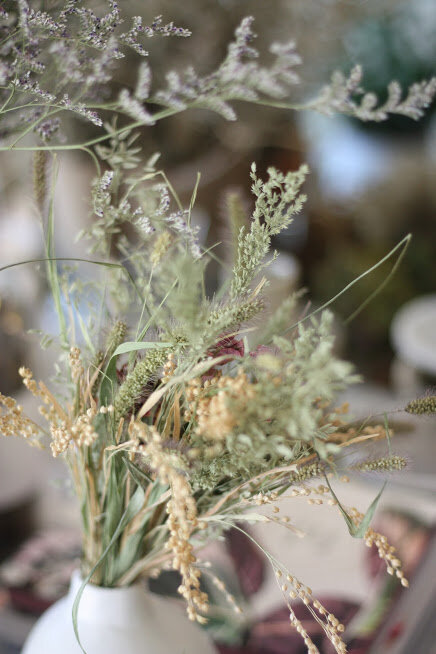Dried Flowers Varieties for Floral Design
Looking at last year, dried materials were our most popular and most profitable section of our sales from flower farming - it was incredible!
But what’s interesting too is that lots of the materials that go into dried material arrangements and products would literally have been composted otherwise. And while I’m all for improving the soil through composting of organic material, there are still plenty of ingredients that can be used for dried florals and bring in money during the off season.
Here are a variety of some of the dried flowers we grow for uses in arrangements, bouquets, wreaths and installations
Basil seedheads are one of our trademark ingredients in our bouquets. The pagoda-like dark-colored seed heads are elegant and structural in bouquets and work well in wreaths and centerpieces. They are a great contrast to the other straw/tan-colored materials that are in larger quantities, and are included in nearly every arrangement that we make.
Dried zinnias are great because they will often hold their color when dried during the season, but they don’t have to necessarily hold their color to be interesting. Their statuesque seedheads are wonderful too, appearing much like echinacea seedheads with spiky seeds and their cone-like shape and thick stems. The petals won’t hold very well usually, but that’s okay given the structural form of their seedheads. Great when paired with fluffier, airier materials.
Statice is an old-school flower that has come back into fashion, but really only comes into its own when it comes to dried florals. The green, fleshy ribbed stalks are not necessarily attractive for conventional floral arranging but when dried are a wonderful splash of color and texture. I really like the more pastel-toned yellows, pinks, salmons and white but even the purple and blue varieties work well as color punctuations in arrangements.
Grasses are the mainstay of our bouquets and wreaths, adding form and volume to any arrangement they are a part of. From the smaller fragrant lovegrass seedheads to the gigantic switchgrass and Johnsongrass seedheads that are nearly six inches in diameter to the cylindrical and densely seeded millet foxtail seedheads, the grasses are a great way of bulking out arrangements and adding that lovely airiness to wreaths. They also dry and hold well too without shattering like some other materials.
Limonium (aka sea lavender) is another wonderful dried material that we both grow as well as purchase in. The silvery white flower petals dry similarly to statice and are a wonderful delight when added to wreaths and arrangements and bouquets.
Sedum seedheads are like big bunches of broccoli. Again, a great contrast in comparison to the tan and beige colored materials that they are often paired with but they are invaluable as far as creating good structure and form in arrangements given their large, dark, solid umbellifer shape.
Daucus and the related dill, fennel and ammi seedheads are all delicate and airy in their appearance and are a great way to add airiness and elegance to arrangements. I particularly like using them in centerpieces but they also do well in wreaths and in bouquets. Just make sure they don’t get crushed when wrapping them up into a bouquet sleeve - they get broken quite easily.
Broomcorn seedheads are a stately and large element to add to arrangements, especially ones that require a bit of vertical interest. The dark and glossy seedheads are striking and add movement and rhythm to any arrangement they are arranged into. Even the broomcorn stalks and leaves can be added to arrangements - the leaves look downright tropical when dried and arranged into a vase, while the broomcorn stalks look a bit like horsetail rush or bamboo.
Alliums with their firework-shaped explosions of seedheads are especially wonderful this time of year on their own and mixed with other materials. An old-school favorite is to spray-paint them gold or silver and hang them on trees and from swags to add a bit of twinkly elegance to the home decor.
Oregano flowers well, particularly those with the hops-type flowers such as Kirigami or Kent Beauty. The bigger sprays, such as from ‘Hopley’s Purple’ or ‘Greek’ can be incorporated into bouquets and wreaths, while the smaller sprays can be used for bunching into wreaths and even for taping onto gift tags, cards, and using in dried boutonnieres.
Bachelor Buttons leave behind a very nice silvery seedhead after the flowers have dried out and the petals are plucked away, almost like strawflower but much more tall and elegant. Since we have an abundance of bachelor buttons (being one of the easiest cool flowers for us to grow) we love this final product of the plants at the end of the season. Make sure to harvest earlier to prevent damage from wind and pests and rain.
Strawflowers are a very traditional and great new retro boho dried flower to use in arrangements and wreaths, needing no explanation. Even if you have shorter stems or broken heads, they can still be saved and either wired or taped into wreaths, ornaments, and even boutonnieres and flower crowns.
Celosia when dried are an excellent textural addition to arrangements and bouquets, lending a great structural presence and form that helps to break up the airy and foamy fillers like grasses and limonium. We really like the cockscomb heads, but even the wheat-type celosia works well.
I hope this gives you some idea as far as the type of materials you can use for your dried floral sales this year. If you are interested in learning more of how we plan, grow, harvest, design and sell our dried florals, check out our eBook below on growing dried flowers for flower farmers!






